Note making techniques
This exercise will explore the numerous approaches you can take to note making. You will learn the various options for note making in different contexts and explore the advantages and features of each approach.
Select a type of note making below to learn more.
-
Quick reference
-
Case study summary
-
Essay
-
Flowchart
-
Mindmap
-
Thematic table
-
Visual diagram
Now that you have gone through all parts of the exercise, you can return to the main Library website by selecting the 'Back to Note making' button below.
Quick reference
The image below is an example of a set of quick reference notes. To proceed with the exercise and explore the features of these notes, select the 'Learn to make these notes' button below.
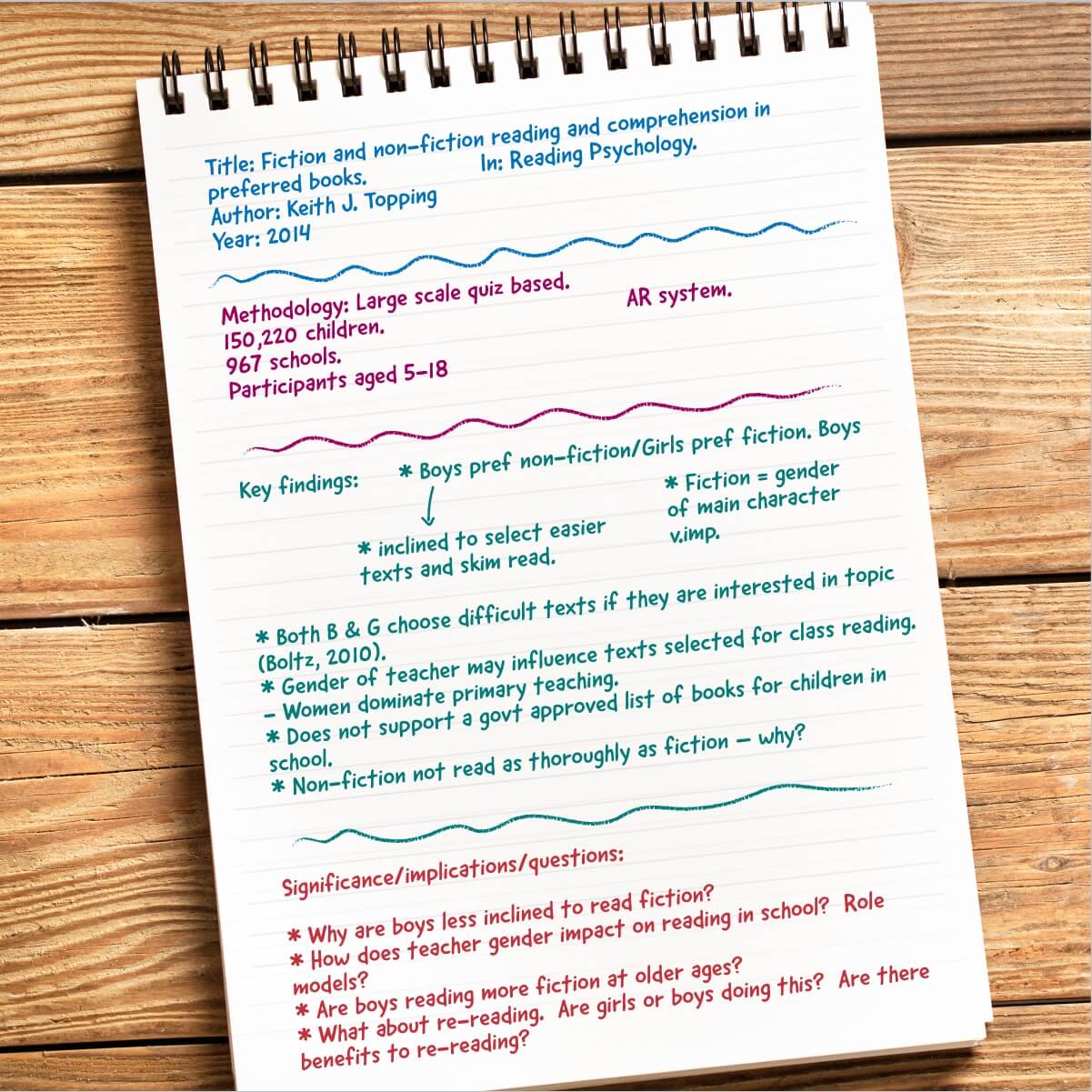
Quick reference
This section will provide an outline of the features of quick reference notes.
The digital notebook below is currently blank. Select the 'Add note' button to begin building the digital notes and get an explanation of useful elements. You may need to scroll within the notebook to see everything.
Notebook
Overview
- Title: Fiction and non-fiction reading and comprehension in preferred books. In: Reading Psychology.
- Author: Keith J. Topping
- Year: 2014
Methodology
- Large scale quiz based.
- 150,220 children.
- 967 schools.
- Participants aged 5-18.
- AR system.
Key findings
- Boys pref non-fiction/Girls pref fiction.
- Fiction = gender of main character v.imp.
- Both B & G choose difficult texts if they are interested in topic (Boltz, 2010).
- Boys inclined to select easier texts and skim read.
- Gender of teacher may influence texts selected for class reading.
- Women dominate primary teaching.
- Does not support a govt approved list of books for children in school.
- Non-fiction not read as thoroughly as fiction – why?
Significance/ implications/ questions
- Why are boys less inclined to read fiction?
- How does teacher gender impact on reading in school? Role models?
- Are boys reading more fiction at older ages?
- What about re-reading. Are girls or boys doing this? Are there benefits to re-reading?
Case study summary
The image below is an example of a set of case study summary notes. To proceed with the exercise and explore the features of these notes, select the 'Learn to make these notes' button below.
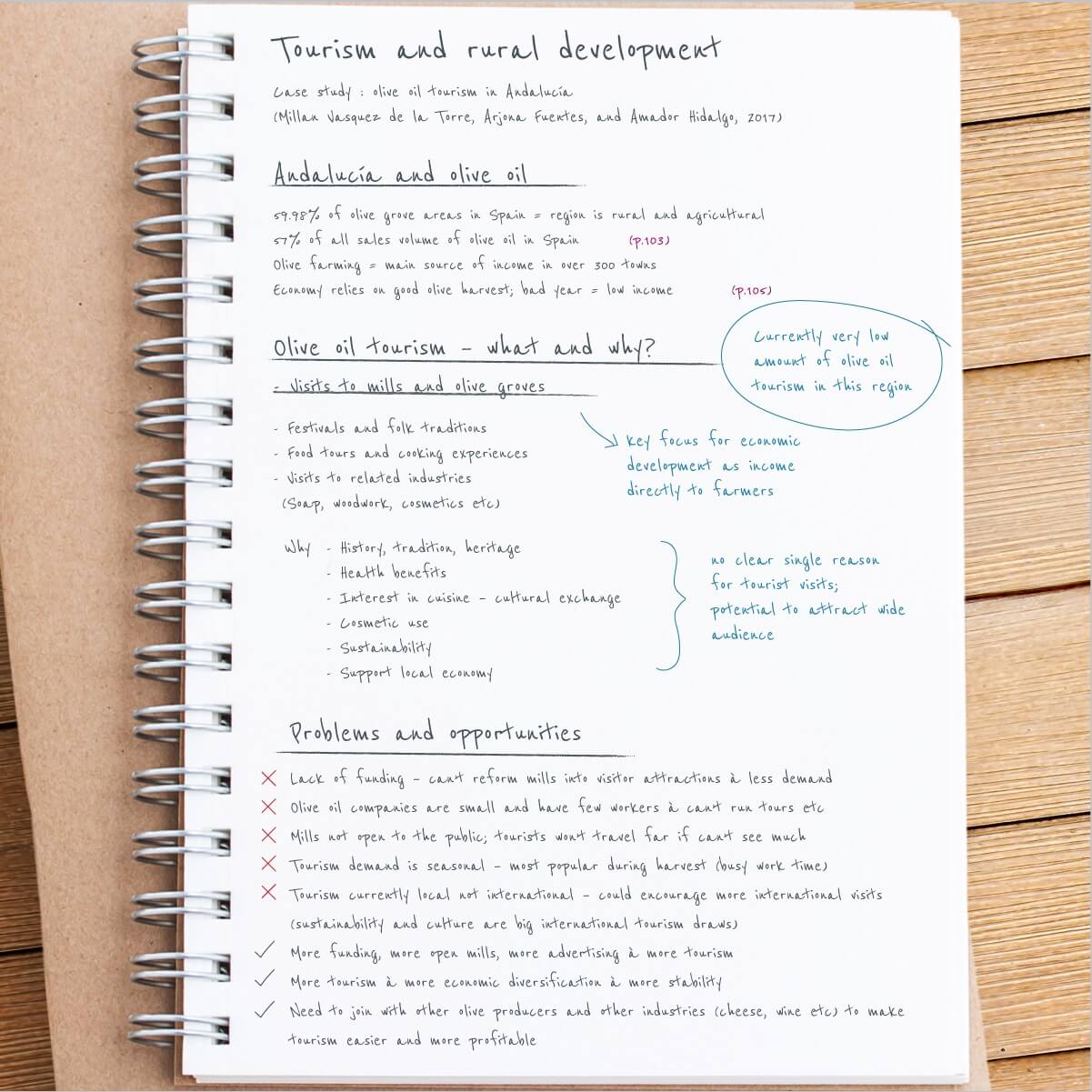
Case study summary
This section will provide an outline of the features of case study summary notes.
These notes are a summary of a case study about a specific type of tourism in a Spanish region. The notes utilise certain features that make them effective in a case study summary.
Select each of the tab indicators below to highlight the corresponding features in the notebook.
Notebook
Tourism and rural development
Case study : olive oil tourism in Andalucía
(Millan Vasquez de la Torre, Arjona Fuentes, and Amador Hidalgo, 2017)
Andalucía and olive oil
- Andalucía: 59.98% of olive grove areas in Spain = region is rural and agricultural
- 57% of all sales volume of olive oil in Spain (p.103)
- Olive farming = main source of income in over 300 towns
- Economy relies on good olive harvest; bad year = low income (p.105)
Olive oil tourism – what and why?
Currently very low amount of olive oil tourism in this region
What
- Visits to mills and groves – key focus for economic development as income directly to farmers
- Festivals and folk traditions
- Food tours and cooking experiences
- Visits to related industries (Soap, woodwork, cosmetics etc)
Why [no clear single reason for tourist visits; potential to attract wide audience]
- History, tradition, heritage
- Health benefits
- Interest in cuisine – cultural exchange
- Cosmetic use
- Sustainability
- Support local economy
Problems and opportunities
- Lack of funding – can’t reform mills into visitor attractions less demand
- Olive oil companies are small and have few workers can’t run tours etc
- Mills not open to the public; tourists won’t travel far if can’t see much
- Tourism demand is seasonal – most popular during harvest (busy work time)
- Tourism currently local not international – could encourage more international visits (sustainability and culture are big international tourism draws)
- More funding, more open mills, more advertising more tourism
- More tourism more economic diversification more stability
- Need to join with other olive producers and other industries (cheese, wine etc) to make tourism easier and more profitable
Essay
The image below is an example of a set of essay notes. To proceed with the exercise and explore the features of these notes, select the 'Learn to make these notes' button below.
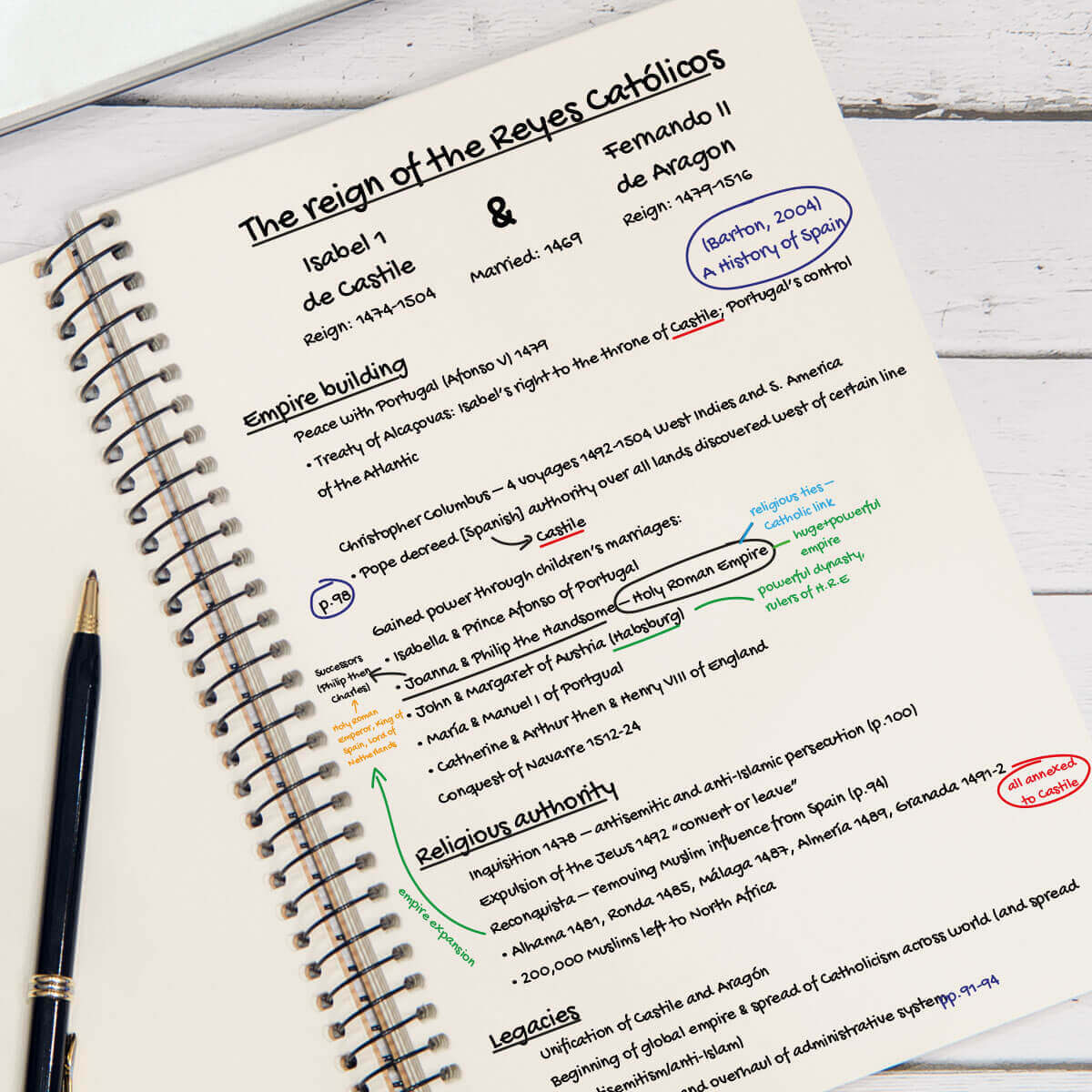
Essay
This section will provide an outline of the features of essay notes.
The digital notebook below is currently blank. Select the 'Add note' button to begin building the digital notes and get an explanation of useful elements. You may need to scroll within the notebook to see everything.
These notes summarise a key topic from a history book, which could be used as an example to illustrate a point being made in an essay-style exam answer.
The notes include key facts about the people and events mentioned in the book.
The main points are organised into themes, which could help with exam questions that focus on a specific aspect of the topic.
The notes include colour-coded annotations which add other important ideas that might come up in an exam or for developing an argument. They also include page numbers to point out where the book contains more details about key events.
View next stepsNotebook
The reign of the Reyes Católicos
| Isabel 1 de Castile: Reign: 1474-1504 | Fernando II de Aragón: Reign: 1479-1516 |
| Married: 1469 | |
| (Barton, 2004) A History of Spain | |
Empire building
-
Peace with Portugal (Afonso V) 1479
- Treaty of Alcaçovas: Isabel’s right to the throne of Castile; Portugal’s control of the Atlantic
-
Christopher Columbus – 4 voyages 1492-1504 West Indies and S. America
- Pope decreed Spanish (Castile) authority over all lands discovered west of certain line (p.98)
-
Gained power through children’s marriages
- Isabella & Prince Afonso of Portugal
- Joanna & Philip the Handsome – Holy Roman Empire grandson Charles Holy Roman Emperor, King of Spain, Lord of Netherlands [Catholic links]
- John & Margaret of Austria (Habsburg) [powerful dynasty, rulers of H.R.E]
- María & Manuel I of Portgual
- Catherine & Arthur then & Henry VIII of England
- Conquest of Navarre 1512-24
Religious authorities
- Inquisition 1478 – antisemitic and anti-Islamic persecution (p.100)
- Expulsion of the Jews 1492 “convert or leave”
-
Reconquista – removing Muslim influence from Spain (p.94) [empire expansion]
-
Alhama 1481, Ronda 1485, Málaga 1487, Almería 1489, Granada 1491-2
[all annexed to Castile] - 200,000 Muslims left to North Africa
-
Alhama 1481, Ronda 1485, Málaga 1487, Almería 1489, Granada 1491-2
Legacies
- Unification of Castile and Aragón
- Beginning of global empire & spread of Catholicism across world (and spread of antisemitism/ anti-Islam)
-
Judicial reform and overhaul of administrative system
(pp.91-94)
Flowchart
This section will provide an outline of the features of flowchart notes.
The digital notebook below contains a flowchart that shows the decision-making process for applying a specific piece of legislation about company resolutions. Select the '+' markers to learn more.
Once you have explored all markers, select the 'View next steps' button following the notebook content.
Company resolutions (Ellis, 2010)
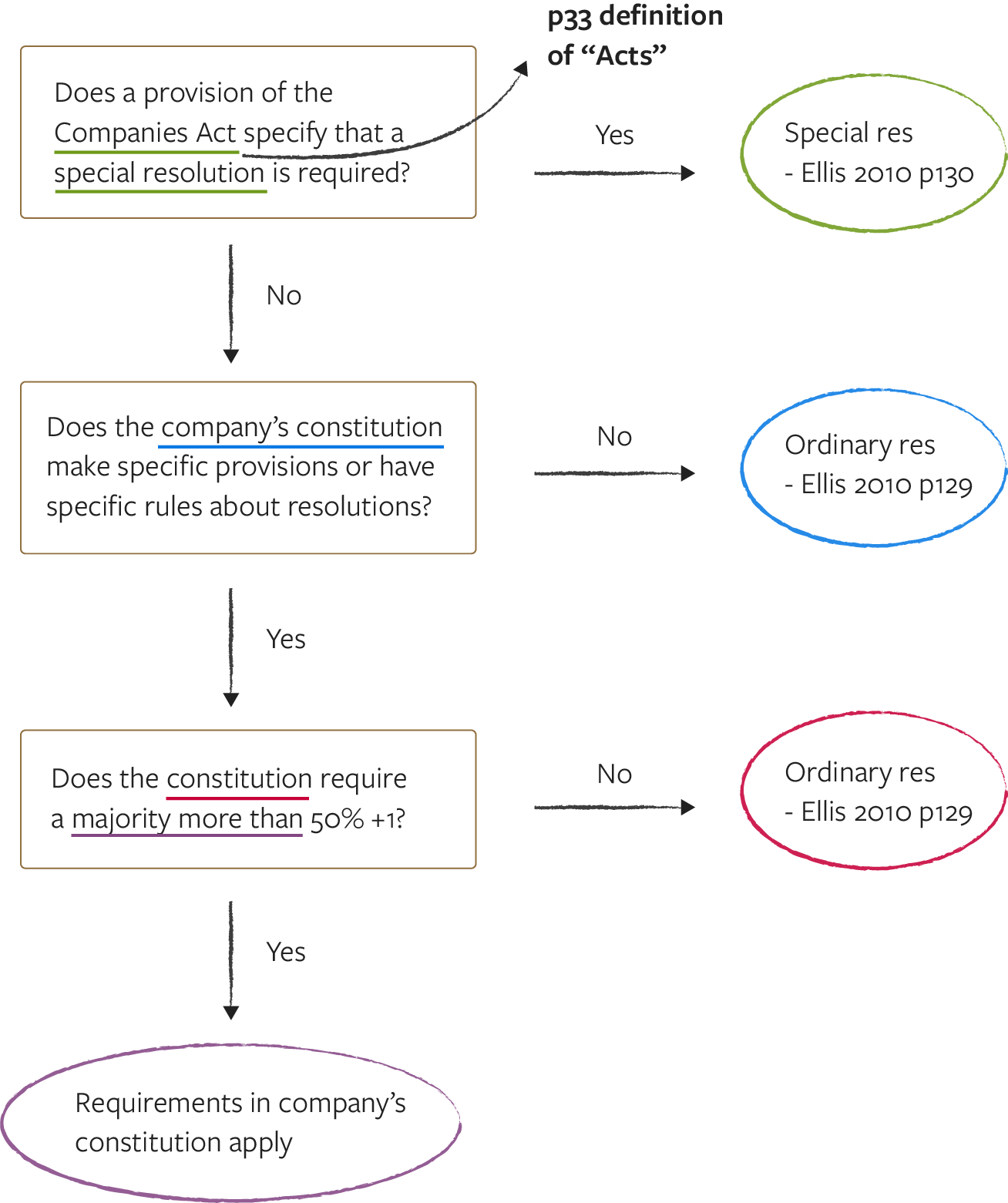
The flowchart has annotations showing the key documents you should refer to in order to help you make a decision.
The flowchart clearly sets out the key questions you should ask and the order you should ask them in.
Q1: Does a provision of the Companies Acts (p.33 for definition) specify a special resolution is required?
- If yes, see Outcome 1.
- If no, see Q2.
Q2: Does the company’s constitution make specific provisions for or have specific rules about resolutions?
- If yes, see Q3.
- If no, see Outcome 2.
Q3: Does the constitution require a majority more than 50%+1?
- If yes, see Outcome 4.
- If no, see Outcome 3.
Outcome 1: Special resolution (p.130).
Outcome 2: Ordinary resolution (p.129).
Outcome 3: Ordinary resolution (p.129).
Outcome 4: Requirements in company’s constitution apply.
Mindmap
This section will provide an outline of the features of mindmap notes. The image below displays a mindmap with a hierarchy of ideas expanding from a central point.
Explore the mindmap and then scroll to see an outline of the key features used.
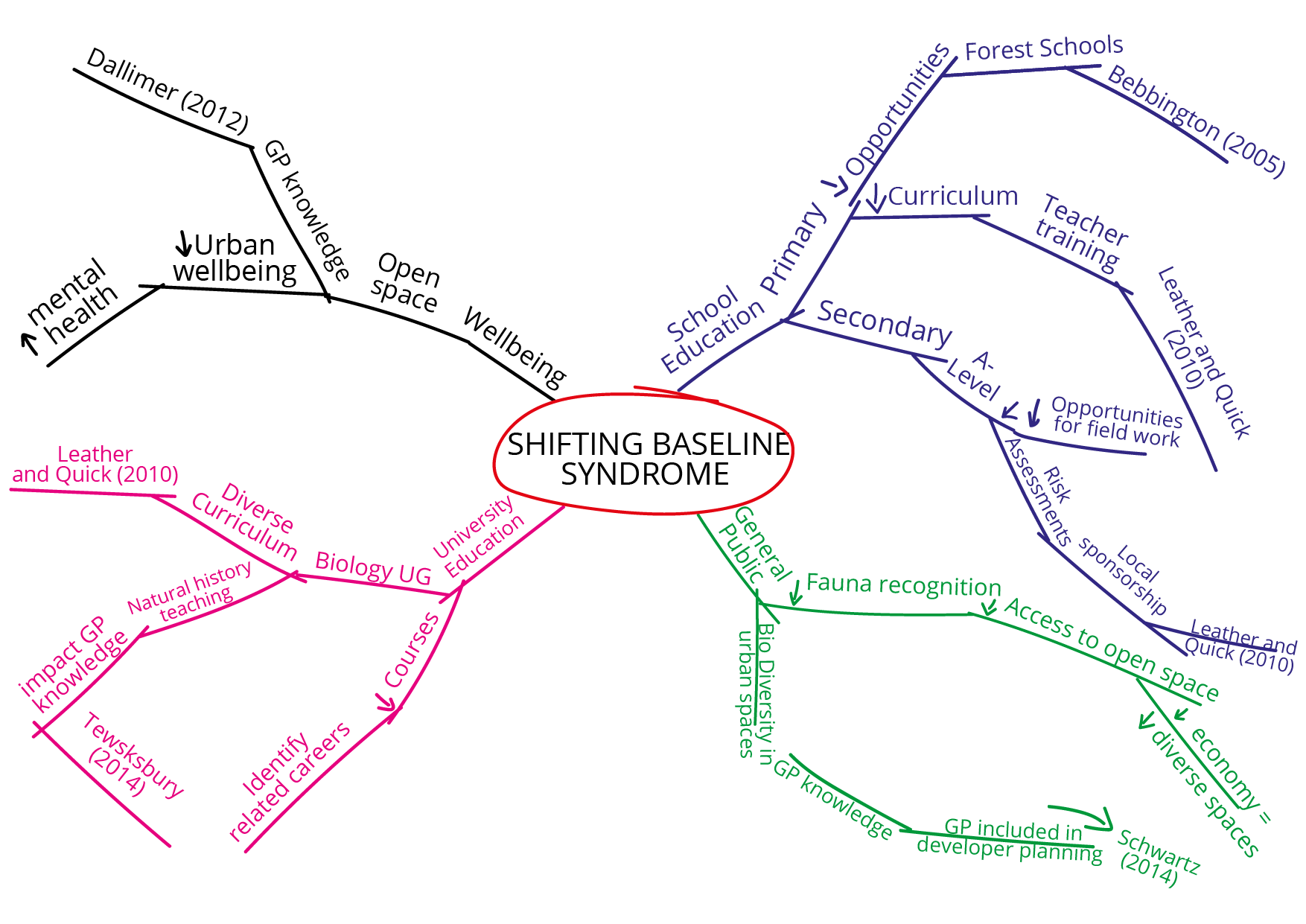
As you're viewing this exercise on mobile, you may wish to download the image to zoom and view the details more easily. You can download the image by selecting the 'Download image' button below.
Download imageShifting Baseline Syndrome
School Education
Primary
Opportunities
Forest Schools
- Bebbington (2005)
Curriculum
Teacher training
- Leather and Quick (2010)
Secondary
A-Level
Opportunities for field work
Risk Assessments
- Local sponsorship
- Leather and Quick (2010)
General Public
Fauna recognition
Access to open space
economy = diverse spaces
Bio Diversity in urban spaces
GP knowledge
GP included in developer planning
- Schwartz (2014)
University Education
Courses
Related careers
Biology UG
Natural history teaching
impact GP knowledge
- Tewsksbury (2014)
Diverse Curriculum
GP knowledge
Leather and Quick (2010)
Wellbeing
Open space
GP knowledge
Dallimer (2012)
Urban wellbeing
mental health
These notes summarise the concept of Shifting Baseline Syndrome using a mindmap. They have some key features:
This mindmap has been created by collecting ideas from several sources to organise ideas and consider relationships between them.
The mindmap starts with the central topic and breaks that down into sub-topics.
By focussing on key ideas written down in your own words, and then looking for branches out and connections between the ideas, you are mapping knowledge in a manner which will help you understand and remember new information.
Thematic table
The image below is an example of a set of thematic table notes. To proceed with the exercise and explore the features of these notes, select the 'Learn to make these notes' button below.
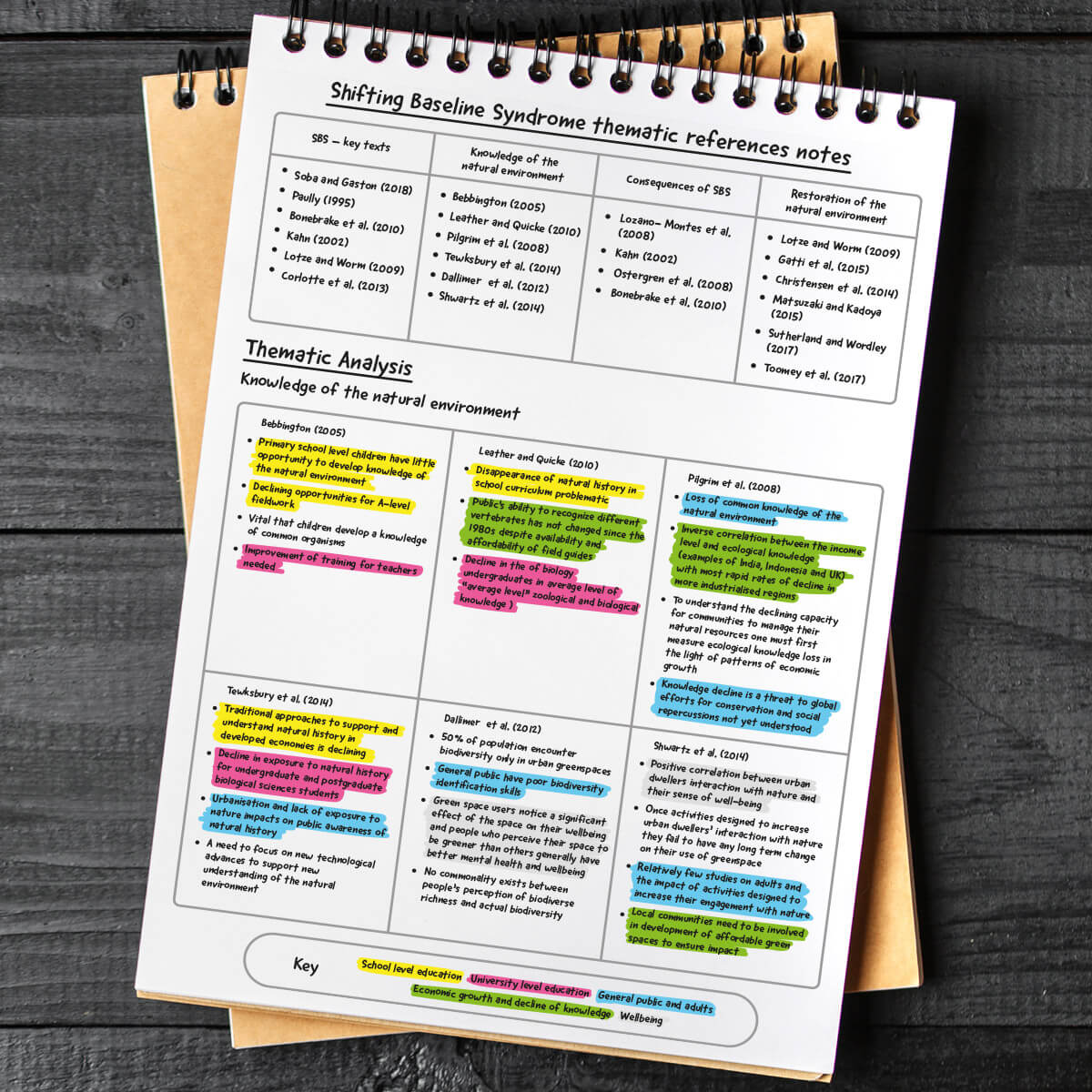
Thematic table
This section will provide an outline of the features of thematic table notes. This thematic table contains several important references, grouped according to their main themes. The table can be used in the open book exam as a quick reference point for the key literature for each of the different themes.
Shifting Baseline Syndrome thematic reference notes
| SBS - key texts | Knowledge of the natural environment | Consequences of SBS | Restoration of the natural environment |
|
|
|
|
|---|
Knowledge of the natural environment
The following table accompanies the thematic table (above). It contains a short summary of each of the main texts identified in the thematic reference table (column 2: Knowledge of the natural environment).
The colour coding identifies distinct themes in each text and could help identify where there are similarities in approach or argument. The table shows a thematic analysis of six sources which identify the common themes you could also use this method to identify disagreements and debates within the literature.
Utilise the key below to select or deselect different themes to see how these are grouped in the table. For keyboard navigation, use the spacebar to select/ deselect the checkboxes.
Key
Bebbington (2005)
|
Leather and Quicke (2010)
|
Pilgrim et al. (2008)
|
Tewksbury et al. (2014)
|
Dallimer et al. (2012)
|
Shwartz et al. (2014)
|
This table could help inform an argument in an essay-style open book exam question, because it can show the development of the discourse. The table would also help you to synthesise sources to include in your writing.
Visual diagram
This section will provide an outline of the features of a visual diagram. The image below displays a visual diagram with collection of ideas organised based on their relationship to each other.
Explore the visual diagram and then scroll to see an outline of the key features used.
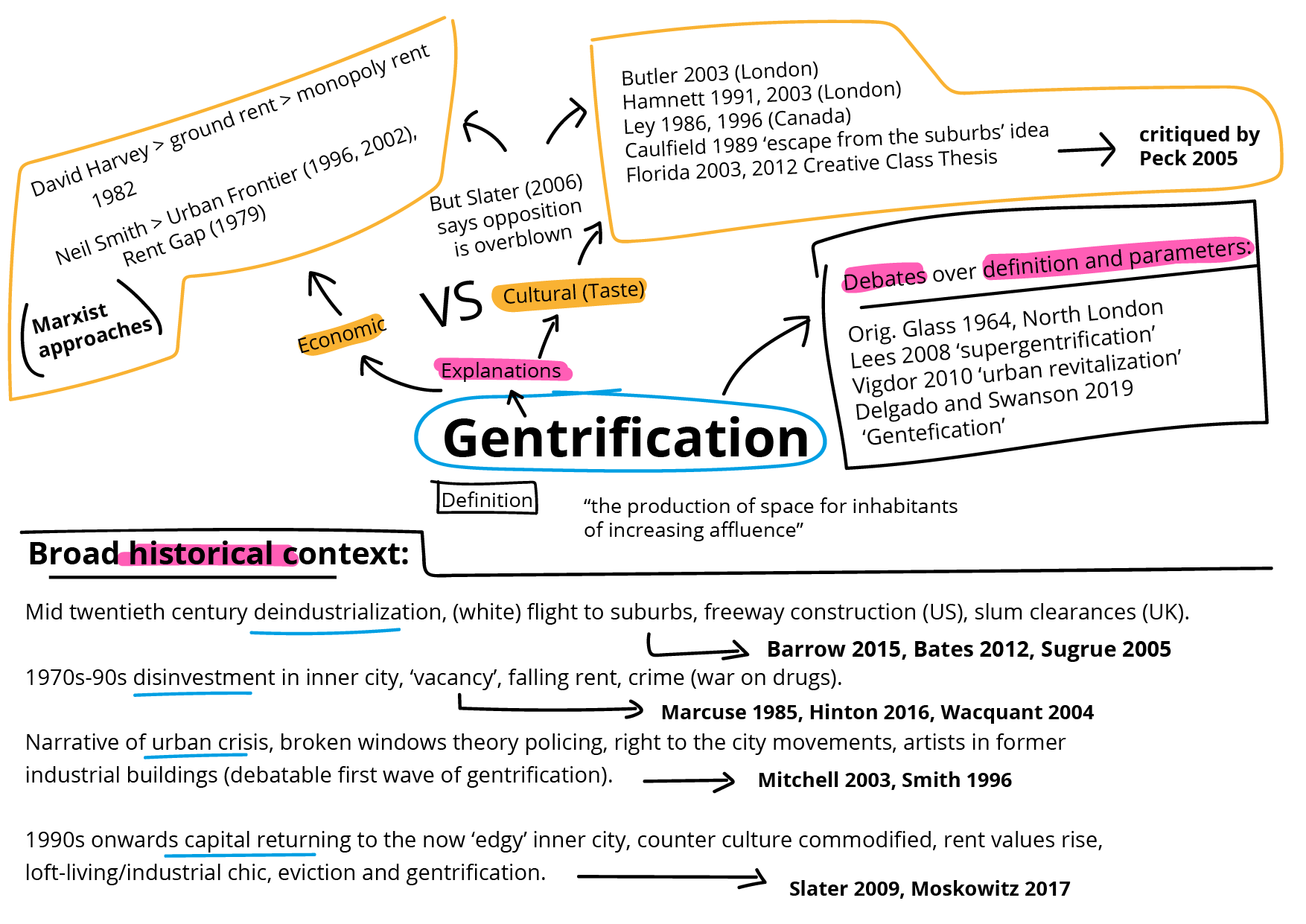
As you're viewing this exercise on mobile, you may wish to download the image to zoom and view the details more easily. You can download the image by selecting the 'Download image' button below.
Download imageGentrification
Definition: the production of space for inhabitants of increasing affluence
1. Debates over definition and parameters
- Orig. Glass 1964, North London
- Lees 2008 ‘supergentrification’
- Vigdor 2010 ‘urban revitalization’
- Delgado and Swanson 2019 ‘Gentefication’
2. Broad historical context
- Mid twentieth century deindustrialization, (white) flight to suburbs, freeway construction (US), slum clearances (UK). Barrow 2015, Bates 2012, Sugrue 2005
- 1970s-90s disinvestment in inner city, ‘vacancy’, falling rent, crime (war on drugs). Marcuse 1985, Hinton 2016, Wacquant 2004
- Narrative of urban crisis, broken windows theory policing, right to the city movements, artists in former industrial buildings (debatable first wave of gentrification). Mitchell 2003, Smith 1996
- 1990s onwards capital returning to the now ‘edgy’ inner city, counter culture commodified, rent values rise, loft-living/industrial chic, eviction and gentrification. Slater 2009, Moskowitz 2017
3. Explanations (Slater [2006] says opposition between economic and cultural is overblown)
3a. Economic explanations (Marxist approaches):
- David Harvey (1982) > ground rent > monopoly rent
- Neil Smith > Urban Frontier (1996, 2002), Rent Gap (1979)
3b. Cultural explanations (Taste):
- Butler 2003 (London)
- Hamnett 1991, 2003 (London)
- Ley 1986, 1996 (Canada)
- Caulfield 1989 ‘escape from the suburbs’ idea
- Florida 2003, 2012 Creative Class Thesis > critiqued by Peck 2005
These notes summarise a key concept in Human Geography, using a visual diagram. They have some key features:
Different theoretical approaches are compared, and important debates in the field are listed.
The notes include the names and works of key academics and useful case studies to draw upon in the exam.
This visual diagram gives a broad overview of the existing scholarship on this topic and could help to identify where you would focus your answer to a question.
These notes have been made about a journal article.
The notes summarise the broad points made in the article. These notes don't go into a lot of detail because they are intended to be used as a quick reference point during an exam or jumping off point for research.
The notes also include some further thoughts about the significance of the article, implications of the findings or questions generated by those findings.
Each section is written in a different colour so that they are easy to identify.
View next steps